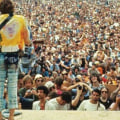Popular culture is often expressed and disseminated through commercial media such as radio, television, movies, the music industry, publishers, and business-run websites. Pop culture finds its expression in the mass circulation of items from areas such as fashion, music, sports and cinema. The world of pop culture had a particular influence on art since the early 1960s, through pop art. How can a country that represents less than five percent of the world's population have a culture that extends far beyond its borders? While the global reputation of the United States has changed when it comes to its politics, its popular culture remains a force for those outside the U.S.
UU. So why does a country that represents less than five percent of the world's population have a culture that extends far beyond its borders? Think of culture as a negotiable commodity. For a long time, the United States dominated this trade, spreading its culture all over the world thanks in large part to Hollywood. At the beginning of the 20th century, Hollywood became the epicenter of film production and, therefore, the starting point of American pop culture.
Decades later, films such as Citizen Kane, Gone with the Wind and Casablanca began to be successful among a wide audience. More recently, television has also penetrated. Let's just say that's one of the main reasons why American pop culture is so popular abroad. The show about twentysomethings in New York City wasn't just a hit here.
It is also a classic in countries such as India, as it offers an overview of life in the United States. These days, the United States is starting to import more media and pop culture from other countries. However, despite the fact that the Internet reduces physical boundaries and the rise of streaming platforms allows foreign productions to capture global attention, some people abroad still think that American pop culture is setting the trend. If that's the case, he anticipates that American pop culture will influence and be influenced by cultures from all over the world.
We've all had goose bumps before, but why do we get it? It turns out that middle names have an interesting historical origin and purpose. The economy is changing and manufacturing jobs are on the rise. The new information about the attack comes amid new reports that law enforcement knew how risky the suspect could have been. Legislators voted 101-6 to remove President Pedro Castillo from office after he tried to dissolve the legislature to avoid an impeachment vote.
While the folkloric element of popular culture has a strong relationship with the commercial element, the public has their own tastes and may not accept all cultural items sold. The dramatic increase in the number of film productions per year reflects the global reach of American popular culture in theaters and speaks of its impressive extension to other cultural spheres. Globalization not only spreads an unparalleled American popular culture, but it also helps implement the economic, political, and cultural ideals of the United States across geographical boundaries. However, mass culture allows people to define themselves in relation to all other members of mass society at the level of a city, country, or international community (such as a widespread language, a former colonial empire, a religion).
By providing a new transmission channel, cyberspace has renewed the strength of this element of popular culture. Globalizing forces are incorporating American popular culture into the world and inserting into it many aspects of civic culture in the United States, so much so that people are becoming obsessed with the United States. Their popular culture has globalized, perhaps it is those people from different continents who have never been to the U. The rich production reflects the general characteristics of the country's ongoing reinvention and redefinition, which are part of what makes the American cultural scene a highly representative and dynamic construction.
Cultural items that require extensive experience, education, training, taste, insight or reflection for their full appreciation rarely become elements of popular culture. Large transnational and multinational companies such as Walmart, Coca-Cola, McDonald's or Microsoft expanded their manufacturing industries in many parts of the world to mass produce their products or services and transport them around the world for mass consumption. In addition, following the theory of cultural imperialism, the domination of a culture favors it as a point of reference for development and progress. In the conditions of modernity, all industries that make a profit by inventing and promoting cultural material have become a principal source.
American cultural identity stems from the totality of the cultural production that this nation has produced and disseminated throughout the world. If one considers culture as a way of defining oneself (an extremely individualistic approach), a culture needs to attract the interest of people (potential members) and persuade them to invest a part of themselves in it. The media and communication technologies in general have allowed cultural products to circulate more freely between different corners of the world. .
.


